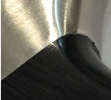- Joined
- Jun 3, 2019
- Messages
- 2,714
Lacking definitive input from the moderators, I am going to follow Randyb's request and start a new thread on this topic. To try to avoid (now and in the future) heated arguments based mostly on opinion, I am proposing, and requesting, that contents of this thread be restricted to concrete knowledge of the underlying mechanisms, materials used (or processed), processes used (with reasonable detail in terms of time/temperature/pressure, etc), and results. I can supply a great deal of the background knowledge and "theory", and am hoping/planning that I can perform and read out to you some specific experiments with regard to resin penetration, AND performance of the resulting impregnated wood (especially moisture uptake and dimensional stability. I wish I could do some measures of mechanical strength, but do not have the resources for that...  ).
).
There is also a great deal of fact-based experience out there - some of which has already been related on the recent previous thread ( https://www.bladeforums.com/threads/stabilized-wood-source.1672650/ ) - especially those by Ben at Greenberg, Willie71. I would like to see those comments re-posted here if the posters agree. I am sure there is other experience/data-based information out there that others can contribute.
I would like to re-iterate that I have no argument that the K&G process results in better penetration than anything we can do at home (and I can/will tell you just why that is). What remains unclear to me is: under what use-conditions does that penetration difference result in a performance difference? (and if so, how great is that performance difference). I have spoken with the folks at K&G (great people!) - and while they have measured penetration, they have no data on the question I am asking - hence my attempt to start this thread and effort at data collection/generation myself. (the folks at K&G know what I am trying, and are ok with it....).
PLEASE speak now and let me know if you are interested in my pursuing this effort. If this is just me and no one else is interested, I will stop. But if there is interest in understanding how your stabilization "home processes" can be improved, and understanding more concretely what their reasonable limits are - then I think this will be useful for folks now and in the future.
(I am sure some are asking "just who is this new guy to do this"? I resist throwing my credentials out there (all of your extensive experience in the craft counts far more than those). suffice it to say that my education and career experience are highly aligned with this particular issue of stabilization and the materials involved. I hope that I can use that to educate (a little), and to help put clarity to this question of "what is good enough versus use expectations" when it comes to the use of stabilized materials.
Please let me know your thoughts...
There is also a great deal of fact-based experience out there - some of which has already been related on the recent previous thread ( https://www.bladeforums.com/threads/stabilized-wood-source.1672650/ ) - especially those by Ben at Greenberg, Willie71. I would like to see those comments re-posted here if the posters agree. I am sure there is other experience/data-based information out there that others can contribute.
I would like to re-iterate that I have no argument that the K&G process results in better penetration than anything we can do at home (and I can/will tell you just why that is). What remains unclear to me is: under what use-conditions does that penetration difference result in a performance difference? (and if so, how great is that performance difference). I have spoken with the folks at K&G (great people!) - and while they have measured penetration, they have no data on the question I am asking - hence my attempt to start this thread and effort at data collection/generation myself. (the folks at K&G know what I am trying, and are ok with it....).
PLEASE speak now and let me know if you are interested in my pursuing this effort. If this is just me and no one else is interested, I will stop. But if there is interest in understanding how your stabilization "home processes" can be improved, and understanding more concretely what their reasonable limits are - then I think this will be useful for folks now and in the future.
(I am sure some are asking "just who is this new guy to do this"? I resist throwing my credentials out there (all of your extensive experience in the craft counts far more than those). suffice it to say that my education and career experience are highly aligned with this particular issue of stabilization and the materials involved. I hope that I can use that to educate (a little), and to help put clarity to this question of "what is good enough versus use expectations" when it comes to the use of stabilized materials.
Please let me know your thoughts...

